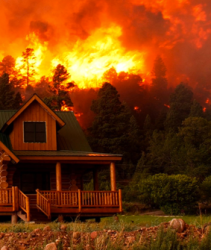
Many groups that participate in our workshops debate the pros and cons of using fear-producing images—like raging fires, devastated forests, and scary pests—in their materials. It’s usually a lively debate and, more often than not, groups opt for more positive images such as healthy woods and families enjoying them.
Fear is one of our most powerful motives. But it is also a very unpleasant emotion and tends to cloud our judgment. The need to reduce fear can drive logical actions to reduce risk; but it can also lead to illogical reactions—like denial of risk or responsibility—that reduce fear without addressing the risk. When fear messages are used too frequently, they can be overwhelming and people simply filter them out.
So when and how can you use fear in your outreach?
1. Fear messages work best when you block the non-logical reactions and offer a clear alternative solution. So, for example, messages that dramatize the ravages of fire will work better when people already accept their vulnerability to fire, thus blocking the denial response. They also work well when the actions that you’re promoting are accepted as an effective and doable way to reduce risk and, thereby, alleviate fear.
2. In communities that don’t yet accept the risk, fear-inducing messages and images can be an effective attention-getter. They will raise curiosity and interest, but you’ll need to build on that to get to action. For example, you may use fear to bring people to a meeting, and activate other feelings and motivators during the meeting to drive preventive action.
3. Finally, the opposite of fear—feelings of control and peace of mind—can be a powerful motivator. In the face of huge, unavoidable risks, people often take action simply to feel that they have some control over the situation or that they have done what they could do to mitigate risk.